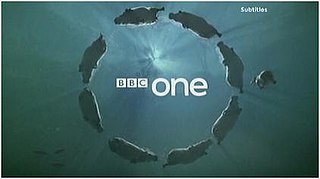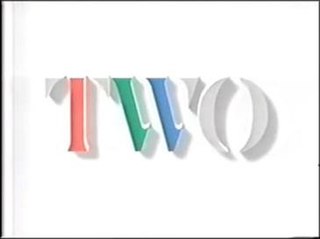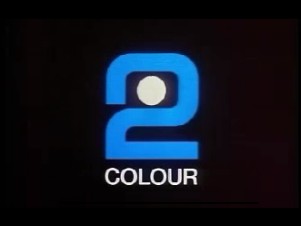The topic of this article may not meet Wikipedia's general notability guideline .(March 2012) |

The "Virtual Globe" was the method of creating the BBC1 symbol that was used between 16 February 1991 and 4 October 1997.
The topic of this article may not meet Wikipedia's general notability guideline .(March 2012) |

The "Virtual Globe" was the method of creating the BBC1 symbol that was used between 16 February 1991 and 4 October 1997.
The Virtual Globe replaced the COW on 16 February 1991 and was designed by Martin Lambie-Nairn, owner of the Lambie-Nairn design agency. [1] The first aspects of the look were first witnessed at 6 am, when the updated Open University symbol first aired, showing the stylised '1'. This was followed at 8 am by the new clock that accompanied the look, introducing a news bulletin. The first time the ident itself aired was at 9 am, when it introduced Going Live! , the Saturday morning magazine show on Children's BBC, where the ident itself was "unveiled" by presenters Phillip Schofield and Sarah Greene. [2]
The ident consisted of a figure "1" inside a rotating transparent globe surrounded by a swirling smoky atmosphere above the BBC's corporate logo: the bold italic letters B B C within three rhomboids, above blue red and green flashes. The idents were created by filming a physical globe, but used CGI effects to give it its smokey look. The ident had no soundtrack and was played off a Sony Laserdisc implementation, Sony CRVdisc. [3] Upon first impressions, the ident does not appear like a globe, as the smoky CGI effects hide and disfigure the continents. However, land masses can be seen in the globe and their shadows can be seen on the background of the ident. [4]
A clock accompanied the look, which used GNAT (Generator of Network Analogue Time), resulting in the clock mimicked the movement of an analogue clock by moving the minute hand every second, rather than every 15 seconds as was found on previous station clocks. The counters on the clocks alternated between dots and dashes pointing towards the centre, a smoky static background and included the BBC logo at the bottom of the screen, although no on screen reference to the channel being BBC1. The clock was originally large to fit the screen best, however the size contrast between the clock and the globe resulted in difficulty at closedown, as the two do not fade easily. This issue was resolved in November 1991, when the clock was shrunk down to the same as the globe, easing fading between. The background was also altered to a ripple effect, yet retaining the smoky feel.
The look also featured an updated style of captions and promotions. Promotions featured the '1' above a BBC logo in the top left of the screen, with the end screen of promotions featuring the programme name at the bottom of the screen. Captions were similar, being formed of a sidebar with the '1' and BBC logo in top left corner with the background of the sidebar featuring a smoky background similar to the ident. [5]
| Title | Air dates | Description |
|---|---|---|
| Virtual Moon | Christmas 1991 | Similar to the normal ident but the figure ‘1’ is inside a rotating, icy coloured moon, with Father Christmas in his sleigh flying around it. When it introduced the film Batman , the bat symbol was superimposed on top. It was accompanied by a simple four note fanfare. |
| Toy | Christmas 1992 | A shining figure ‘1’ is at the bottom of a Christmas tree surrounded by various bouncing and moving toys. A photograph of HM The Queen was used at closedown because the BBC deemed the ident "too jolly" to be used against the National Anthem. |
| North Pole | Christmas 1993 | An icy figure ‘1’ is in a snowy landscape, with two polar bears and Father Christmas in his sleigh flying above it, which the bears watch. There are two versions, one in day-time and one in night-time. |
| Christmas Present | Christmas 1994 | The figure ‘1’ is a Christmas present with a snowman either side of tipping their hats. This ident was unusual in that it had three different variations. In the run up to and on Christmas Eve it was neatly wrapped, on Christmas Day it was unwrapped by the snowmen to reveal a shining gold numeral and on Boxing Day and onwards the wrapping remains had been removed to display the gold numeral ‘1’. The Christmas Day version was occasionally used on and after Boxing Day. Normal idents were used for closedown. |
| Star | Christmas 1995 | The figure ‘1’ is on top of a Christmas tree in place of a star, with starry glitter surrounding it and a toy plane flying around it. In addition, a variation was made without the plane, which was used at closedown. |
| Gift Box | Christmas 1996 | A circular box is opened by two toys to reveal a gold figure ‘1’ inside. A version without the toy figures was used for Closedown and introduction into serious programming, should the need arise. |
The ident set was replaced following a detailed look at the corporate identity. Lambie Nairn, who carried out the investigation found that the current slanted logo did not work on screen well, and therefore suggested replacing it with a new logo featuring straightened boxes. The development of this new logo made the old one, still in use on the idents, redundant. Also, as part of this rethink, Lambie Nairn recommended using the BBC logo, with the service name after, instead of unique logos and numerals for each service, as this weakened the core brand. As a result, he suggested that the identity be changed, with personality added through the ident subject rather than a logo. He therefore developed the idea of a hot-air balloon as the new idents. They went into service on 4 October 1997.
BBC World Service Television, often abbreviated to WSTV, was the name of two BBC international satellite television channels between 1991 and 1995. It was the BBC's first foray into worldwide television broadcasting. In Europe, it was the successor to BBC TV Europe, which it replaced on 11 March 1991. The service was also launched in Asia as a 24-hour news and information service with minor differences, a precursor to BBC World News, launched on 14 October 1991.

The BBC One Balloon idents were a series of idents used on the British TV channel BBC One from 4 October 1997 to 28 March 2002. The balloon theme replaced the computer-generated spinning globe that had been used as the main ident on the channel since 1991. It launched on the same day as a BBC-wide rebrand, and thus the new idents also carried the new BBC logo. The channel's name also changed from BBC1 to BBC One. This was the last ident set used by the channel when it fully closed down; the last proper closedown took place in the early hours of 9 November 1997. Starting the following day, BBC News 24 would broadcast on BBC One during closedown, which continues today.

The BBC One 'Rhythm & Movement' idents were a set of on-screen channel identities designed by Lambie-Nairn and used on BBC One from 29 March 2002 to 7 October 2006. They replaced the balloon idents, and spelled the end of the much recognised globe identity by the BBC, which had been used in various ways since 1963.

Noddy was a camera system used for generating idents for the BBC One and BBC Two television channels from late 1963 to February 1985.
The history of BBC television idents begins in the early 1950s, when the BBC first displayed a logo between programmes to identify its service. As new technology has become available, these devices have evolved from simple still black and white images to the sophisticated full colour short films seen today. With the arrival of digital services in the United Kingdom, and with them many more new channels, branding is perceived by broadcasters to be much more important, meaning that idents need to stand out from the competition.

The Computer Originated World (COW) was the method of creating the BBC1 symbol that was used between 18 February 1985 and 16 February 1991. It was later used by the international, commercial television service BBC World Service Television from its launch until 26 January 1995.

The BBC One 'Circle' idents were a set of on-screen channel identities used on BBC One from 7 October 2006 to 4 December 2016. They also featured on the BBC Studios channel, BBC America. The idents contained images of circles being formed by nature, or people and their actions. This was the longest set of idents that was used by BBC One, as they lasted for 10 years.

The BBC Two '1991–2001' idents were broadcast from 16 February 1991 until 19 November 2001, and again from 9 July 2014 until 26 September 2018, on BBC Two in the United Kingdom. The idents, which consisted of a sans-serif '2' in Gill Sans, accompanied by the colour viridian, were created by branding agency Lambie-Nairn, who also created the Channel 4 logo.

Martin John Lambie-Nairn was an English designer. He was the founder of his branding agency Lambie-Nairn and was the creative director of branding agency ML-N. He is recognised for having redefined television brand identity design, being the first to embrace computer technologies to apply branding to screen-based media.
The logo of the BBC has been a brand identity for the corporation and its work since the 1950s in a variety of designs. Until the introduction of a logo in 1958, the corporation had relied on its coat of arms for official documentation and correspondence, although this crest rarely appeared onscreen. With the increased role of television for the BBC in the 1960s, particularly after the foundation of ITV, the corporation used its logo to increase viewer familiarity and to standardise its image and content. The logo has since been redesigned a number of times, most recently in 2021 with the BBC blocks, a logo designed to work across media. From 1958, for this television network, there have been six different logos. The first logo of the network was used from 1958 to 1963, the second from 1963 to 1971, the third from 1971 to 1992, the fourth from 1988 to 1997, the fifth from 1997 to 2021, while the sixth and current logo was adopted in October 2021.

The BBC TwoPersonality idents were a set of idents used on BBC Two from 19 November 2001 until 18 February 2007. The idents were produced by the Lambie-Nairn branding agency, who had created the previous look. The idents feature an ivory sans serif white '2' in a yellow environment and performing a variety of tasks, and a purple boxed BBC Two logo.

The BBC Two 'Two' ident was the station identification used on BBC2 between 30 March 1986 and 16 February 1991. It was the last non-corporate look for the channel, and the only look until 2018 that did not feature a numeral '2' in the design.
BBC Schools, also known as BBC for Schools and Colleges, is the educational programming strand set up by the BBC in 1957, broadcasting a range of educational programmes for children aged 5–16. From launch until June 1983, programming was based on BBC1 during the daytime, apart from coverage of major news events which saw the programmes shifted to BBC2. In September 1983 programming was transferred permanently to BBC2 freeing BBC1 to develop its own daytime schedule. The strand, named Daytime on Two, remained on BBC Two until March 2010, later supplemented by the 'Class TV' strand on the CBBC Channel.
BBC One used a number of different idents from the time of the station launch on 2 November 1936 until the station took on the Mirror Globe Idents on 15 November 1969.

The Computer Generated 2 was an ident used by BBC Two between June 1979 and 30 March 1986. It was the first computer generated television station identification in the world.
The Striped 2 was an ident used by BBC2 between 28 December 1974 and June 1979. The ident featured a numeral 2 made out of horizontal lines.

The Cube 2 was an ident used by BBC Two between 2 December 1967 and 28 December 1974. It featured a stylised '2' that rotated on screen.

The Launch ident was a television station identification used by BBC Two between their launch night in 1964 and the introduction of colour in 1967.
Throughout the years, Children's BBC, and later CBBC and CBeebies, have used a number of different identities. The branding of the stranded service is distinctive both in the past and at present.
The presentation and the identities of the BBC News Channel, the international counterpart BBC World News and the BBC Parliament coverage channel use specific identities that demonstrate their remit and purpose.